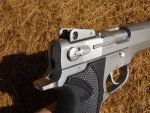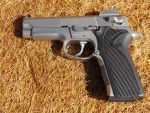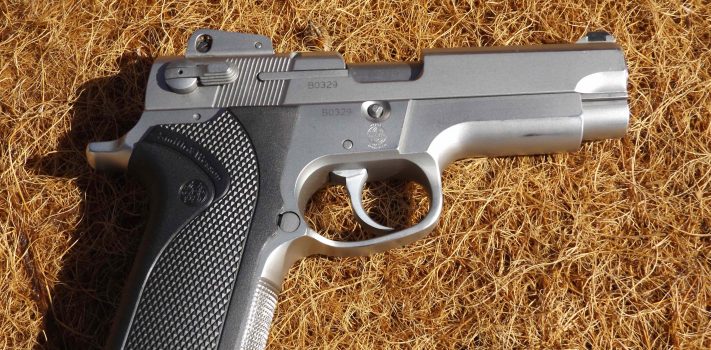All stainless steel handguns, are quite the marvel – well, at least they used to be. I still remember the very first stainless steel handgun I ever saw, it was the Smith & Wesson Model 60, a little 5-shot snubby revolver – it sold like crazy. However, when it came to semi-auto pistols, there were some serious issues with a stainless steel frame and slide – if the two parts were made from the same formulation of stainless steel, it would “gall” – after a few shots if the gun wasn’t heavily lubed, the two same stainless steels would mesh together in such a way, that the gun would jam – the same stainless steels – would rub against one another, causing friction in short order, and the slide wouldn’t move back and forth on the frame. Not a good thing.
I owned a then Safari Arms sub-compact 1911 – and it was quite the work of art back in 1980, and it was a great carry piece. I now wish that I had kept it – if for no other reason than nostalgia. However, the frame and slide were made out of the same stainless steel and if the gun wasn’t kept heavily lubed, the slide would stop moving back and forth on the stainless steel frame. It didn’t take gun makers long to figure this out – I don’t know why they didn’t realize this problem, before guns were shipped – surely, they tested those firearms. Now, when you see a stainless steel semi-auto with a slide and frame that are made out of stainless steel, it is slightly different types of stainless that they are using – and it solved the problem of galling.
Some of our long-time readers have requested, once again, that I do more articles on all-steel firearms, especially semi-autos. We try to not let our readers down, and if I have firearms in my meager collection, that qualifies for an article, I’ll sure do some testing on it. Today, we are looking at the S&W Model 4006 – and it was quite the handgun when it first came out in 1990, chambered in the then fairly-new .40 S&W caliber – it was all the rage, back then!
I actually didn’t have this Model 4006 in my collection, however, I ran across a great deal on a used, but as-new model, at my local gun dealer, and I couldn’t afford to pass up the deal. I had owned a Model 4006 some years back, so I was more than a little familiar with it. However, I forgot just how heavy this handgun was – it comes in at 37.3-oz – very heavy compared to the polymer handguns we see on the market today. The 4006 was actually meant for law enforcement duty carry – and not especially suited for concealed carry – but it is easy enough to conceal, with the right holster and covering garments. Now in my Golden Years, I don’t want to carry a heavy handgun when there is no need to. So this 4006 was purchased just for fun shooting purposes.
S&W 4006 Specs
A quick run down on the specs is always in order, this S&W model comes in with a 4-inch barrel, and it came with two 11-round magazines. One had a yellow follower, while the other mag, had a blue follower. At some point, S&W changed the follower from yellow to blue. Both mags worked without issue. Of course, chambered in .40 S&W caliber is nice – it is more potent than the 9mm round is. I still remember when the .40 S&W first came out, and many, many gun writers derisively called it the .40 Short & Weak – because it was basically a cut-down 10mm case, that wasn’t nearly as powerful as the 10mm round was.
The FBI found out in short order, that the 10mm was too powerful – lots of recoil – for many of their agents, and they went in search of something more powerful than the 9mm, and less powerful than the 10mm. Funny how things worked out – the FBI and many other law enforcement agencies have now returned to the 9mm round – saying better performing ammo is the reason why they changed back to the 9mm. It still comes down to shot placement – if you don’t hit what you’re aiming at, it doesn’t matter what caliber of handgun you are shooting. Now, to be sure, the .40 S&W round is anything but “Short & Weak” if you ask me. There is plenty of power there for self-defense use. Plus, we now have many different types of ammo to choose from as well.
I recently obtained the brand-new .40 S&W round from Black Hills Ammunition – with their new HoneyBadger 115-gr bullet, and it is outstanding – it is moving about 1,300-feet per second from a duty sized handgun, and has close to 450-foot pounds of energy – that’ll get the job done. More on this round later.
 The 4006 has a one piece grip that is made out of the then-new Xenoy plastic – very tough stuff, and better than the old two piece plastic grips S&W was using on many of their semi-auto pistols. My sample has the fully-adjustable rear sight – two dots on either side of the sight’s opening, and the front sight has a single white dot. I’ve always liked the adjustable sights S&W used to use on semi-auto handguns. There is a magazine disconnect, something law enforcement wanted – if there is no magazine in the gun, it can’t fire…if an officer thought he was losing control of his firearm, he could press the mag release and dump the mag from the gun, and the bad actor couldn’t fire the gun without the mag in it. Pretty much all of law enforcement have gotten away from that thinking, because of snatch-resistant duty holsters.
The 4006 has a one piece grip that is made out of the then-new Xenoy plastic – very tough stuff, and better than the old two piece plastic grips S&W was using on many of their semi-auto pistols. My sample has the fully-adjustable rear sight – two dots on either side of the sight’s opening, and the front sight has a single white dot. I’ve always liked the adjustable sights S&W used to use on semi-auto handguns. There is a magazine disconnect, something law enforcement wanted – if there is no magazine in the gun, it can’t fire…if an officer thought he was losing control of his firearm, he could press the mag release and dump the mag from the gun, and the bad actor couldn’t fire the gun without the mag in it. Pretty much all of law enforcement have gotten away from that thinking, because of snatch-resistant duty holsters.
Combo Safety/Decocker
The front strap on the 4006 is machine checkered – not a bad job by S&W, but they could had extended the checkering up and down a little bit more than they did on the front strap, still it works with what S&W did. There is an ambidextrous safety/decocker – so you can decock the gun once you have chambered a round, or have stopped firing. Some people still think it is “dangerous” when an older semi-auto has the hammer safely lowered using a decocker – they some how believe it is safer to place your thumb on the hammer and pull the trigger and lower the hammer that way. That is just stupid! Many accidental discharges have  happened because the hammer slipped off their thumb, causing the gun to fire. You will still see this foolish maneuver in Hollywood movies – obviously, they didn’t use any technical advisors who knew anything about handgun safety. Use the decocker! Once the hammer is safety lowered, you can push the safety/decocker back into the up position and the gun is ready to fire when you pull the trigger simple as that.
happened because the hammer slipped off their thumb, causing the gun to fire. You will still see this foolish maneuver in Hollywood movies – obviously, they didn’t use any technical advisors who knew anything about handgun safety. Use the decocker! Once the hammer is safety lowered, you can push the safety/decocker back into the up position and the gun is ready to fire when you pull the trigger simple as that.
The 4006 sample I purchased, was more than likely a police trade-in at some point. The hammer doesn’t have a spur on it – so no thumb cocking the gun before firing. It can only be fired by pulling the trigger for the first shot – a long, but not overly long double action trigger pull, then every shot after that, is fired single-action. The trigger pull wasn’t all that bad in the long double action pull, either. One of the biggest, if not “the” biggest law enforcement agency to adopt the 4006 was the California Highway Patrol (CHP) “CHiPs” as they were called – or “Chippies.” And they had great success with the gun and the caliber it was chambered in. Their guns didn’t have a bobbed hammer – it had a hammer spur.
My Testing
I didn’t have a big selection of .40 S&W ammo on-hand for testing through the 4006. From Black Hills, as already mentioned, their brand-new HoneyBadger load, and it looks promising as a self-defense round, their 155-gr JHP, 180-gr JHP and their 140-gr Barnes TAC XP, all copper hollow point. From Buffalo Bore Ammunition I only had their 200-gr Hard Cast FN Outdoorsman load – and this is one deep penetrating round. My target was set at 25 yards, and all accuracy testing was conducted using a rolled-up jacket, over the hood of Dodge Ram pick-up. In my testing, I fired more than 300 rounds. Again, I didn’t have a lot of .40 S&W ammo on-hand for this test.
With the all stainless steel 4006, recoil wasn’t anything to pay attention to, except with the Buffalo Bore Outdoorsman load. The hefty 37.3-oz weight kept the gun on-target. If I did my part, I could get groups of 3.5-inches with the Black Hills 180-gr JHP load – and this is the original bullet weight/velocity that the .40 S&W caliber came in – its still a good load. All other loads were hanging in there at 4 inches. I had hoped for better accuracy from this like-new pistol, however it was still more than combat accurate. The new HoneyBadger load was a pussycat to fire – not a lot of recoil, but lots of “fire” out of the end of the barrel – I liked it. If you are going out in the boonies where you might run across dangerous four-legged critters, then the Buffalo Bore 200-gr Hard Cast FN round is the only way to go – it penetrates deeply and doesn’t come apart. That makes it a great load for dangerous game defense.
Few Holster Options
The only problem with owning an older gun, like the S&W 4006, is that very few holster makers are producing concealed carry holsters or even duty holsters for these “ancient” handguns. However, if you search around you can find something – even if it is a generic ballistic Nylon holster – better than nothing – but not my first choice.
All things considered, the 4006 would still make an outstanding duty gun, and 11+1 rounds of .40 S&W on-tap is still a good option. If you desire an all stainless steel handgun, these days, you could do a lot worse than this 4006. And, prices are good on used guns – especially law enforcement trade-ins. It seems that everyone wants a “plastic” handgun these days, so there are lots of used 4006 handguns out there.











I have had a model 5906 in 9mm since the mid nighties, All stainless,17 rd mags, night sights, 5″ ported bbI love the weapon and has served me well. Still have my brothers s&w mod 59 like in the box new. Good article.
It’s America. You’ve got a right to spend your money how you want. But, son, you’ve got it bad.
I have a 4006 CHP trade in. Fun gun to own and shoot, and appreciate for it’s use as a duty weapon. Would never carry the thing though. It weighs more than the Titanic’s anchor.
I enjoyed this article /review very much. Pat, thanks for a good article. I have never owned a model 4006. But I wanted a 5906. If I ever find a good used one, I may try it out.
Years ago I bought a 4006 S&W with nite sights for a bed side gun. It was a natural pointer, but too heavy for its size for a carry gun in my opinion. A couple of years later we were burglarized and it was stolen. I reported the theft, and to prove a point on checks, just over a year after it was stolen it was recovered in a large city in our state. The charge on the arrest was CCW, and the 4006 was placed in the property section where it languished for some 16 years. The Pd was going through their property section cleaning out un-needed evidence and ran the serial number. They then contacted my insurance company who contacted me, asking if I would buy the gun back. I told them that after this length of time and having no idea how it had been treated I would not. Then they made an offer that if I would drive the 240 mile round trip I could just pick it up. I agreed. When I picked the gun up, the nite sight ampules had been broken, there were 5 rounds of .40 live ammo, and 1 9mm fired casing in the box with it, and the slide had been locked back for 16 years making me suspect the recoil spring was compromised. The action was filthy from the blow by if the fired 9mm round. All criminals are not masterminds, as was not the cop who arrested the possessor of the stolen gun. All he had to do was run the numbers to find the gun was stolen. After that many years I had lost or thrown away the schematics so cleaned it by trial and error. The 4006 is easily disassembled, but without the schematics, reassembly is like working a jigsaw puzzle with no picture. There are a large number of small parts that fall out the magazine well when the pins are removed from the action. I replaced the springs, cleaned he gun and got it reassembled. I have not replaced the nite sights, and probably never will. A fellow retired cop and I have wondered how many hold ups were pulled using this gun. I have fired it for function and accuracy since it was returned to me, and it is reliable and accurate enough for self defense, but by no means worthy of a target pistol. Right now it is residing in my safe awaiting a trade on a S&W M&P 9 2.0. Anyone want to trade? Post on here and I’ll work with you.
I had to carry one of those for the first 8 years of my career as a LE officer. It was heavy, the magazine disconnect was a liability not an asset, and I saw a few extractors fail at the range. When the dept switched to a SIG I could have bought the 4006 for a good price but passed on it. I’ve never second guessed that decision.
I still miss my old 1006. 🙁
Its getting easy to find your ammo.
https://www.bulkcheapammo.com/